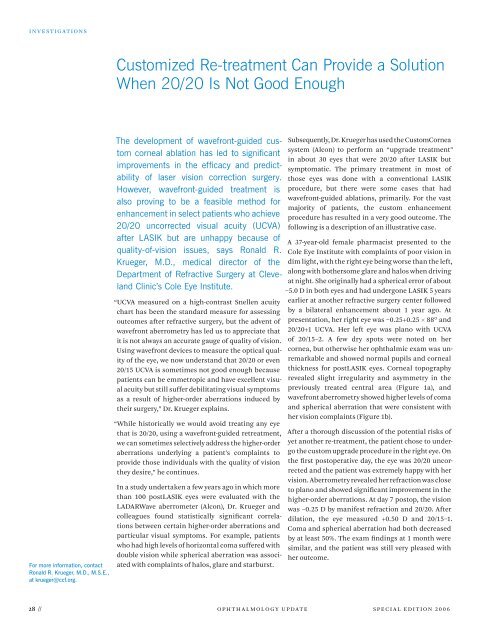Ophthalmology Update - Cleveland Clinic
Ophthalmology Update - Cleveland Clinic
Ophthalmology Update - Cleveland Clinic
Create successful ePaper yourself
Turn your PDF publications into a flip-book with our unique Google optimized e-Paper software.
i n v e s t i g a t i O n s<br />
For more information, contact<br />
Ronald R. Krueger, M.D., M.S.E.,<br />
at krueger@ccf.org.<br />
Customized Re-treatment Can Provide a Solution<br />
When 20/20 Is Not Good Enough<br />
The development of wavefront-guided custom<br />
corneal ablation has led to significant<br />
improvements in the efficacy and predictability<br />
of laser vision correction surgery.<br />
However, wavefront-guided treatment is<br />
also proving to be a feasible method for<br />
enhancement in select patients who achieve<br />
20/20 uncorrected visual acuity (UCVA)<br />
after LASIK but are unhappy because of<br />
quality-of-vision issues, says Ronald R.<br />
Krueger, M.D., medical director of the<br />
Department of Refractive Surgery at <strong>Cleveland</strong><br />
<strong>Clinic</strong>’s Cole Eye Institute.<br />
“Ucva measured on a high-contrast snellen acuity<br />
chart has been the standard measure for assessing<br />
outcomes after refractive surgery, but the advent of<br />
wavefront aberrometry has led us to appreciate that<br />
it is not always an accurate gauge of quality of vision.<br />
Using wavefront devices to measure the optical quality<br />
of the eye, we now understand that 20/20 or even<br />
20/15 Ucva is sometimes not good enough because<br />
patients can be emmetropic and have excellent visual<br />
acuity but still suffer debilitating visual symptoms<br />
as a result of higher-order aberrations induced by<br />
their surgery,” dr. Krueger explains.<br />
“While historically we would avoid treating any eye<br />
that is 20/20, using a wavefront-guided retreatment,<br />
we can sometimes selectively address the higher-order<br />
aberrations underlying a patient’s complaints to<br />
provide those individuals with the quality of vision<br />
they desire,” he continues.<br />
in a study undertaken a few years ago in which more<br />
than 100 postlasiK eyes were evaluated with the<br />
ladarWave aberrometer (alcon), dr. Krueger and<br />
colleagues found statistically significant correlations<br />
between certain higher-order aberrations and<br />
particular visual symptoms. For example, patients<br />
who had high levels of horizontal coma suffered with<br />
double vision while spherical aberration was associated<br />
with complaints of halos, glare and starburst.<br />
subsequently, dr. Krueger has used the customcornea<br />
system (alcon) to perform an “upgrade treatment”<br />
in about 30 eyes that were 20/20 after lasiK but<br />
symptomatic. the primary treatment in most of<br />
those eyes was done with a conventional lasiK<br />
procedure, but there were some cases that had<br />
wavefront-guided ablations, primarily. For the vast<br />
majority of patients, the custom enhancement<br />
procedure has resulted in a very good outcome. the<br />
following is a description of an illustrative case.<br />
a 37-year-old female pharmacist presented to the<br />
cole eye institute with complaints of poor vision in<br />
dim light, with the right eye being worse than the left,<br />
along with bothersome glare and halos when driving<br />
at night. she originally had a spherical error of about<br />
–5.0 d in both eyes and had undergone lasiK 5 years<br />
earlier at another refractive surgery center followed<br />
by a bilateral enhancement about 1 year ago. at<br />
presentation, her right eye was –0.25+0.25 × 88° and<br />
20/20+1 Ucva. her left eye was plano with Ucva<br />
of 20/15–2. a few dry spots were noted on her<br />
cornea, but otherwise her ophthalmic exam was unremarkable<br />
and showed normal pupils and corneal<br />
thickness for postlasiK eyes. corneal topography<br />
revealed slight irregularity and asymmetry in the<br />
previously treated central area (Figure 1a), and<br />
wavefront aberrometry showed higher levels of coma<br />
and spherical aberration that were consistent with<br />
her vision complaints (Figure 1b).<br />
after a thorough discussion of the potential risks of<br />
yet another re-treatment, the patient chose to undergo<br />
the custom upgrade procedure in the right eye. On<br />
the first postoperative day, the eye was 20/20 uncorrected<br />
and the patient was extremely happy with her<br />
vision. aberrometry revealed her refraction was close<br />
to plano and showed significant improvement in the<br />
higher-order aberrations. at day 7 postop, the vision<br />
was –0.25 d by manifest refraction and 20/20. after<br />
dilation, the eye measured +0.50 d and 20/15–1.<br />
coma and spherical aberration had both decreased<br />
by at least 50%. the exam findings at 1 month were<br />
similar, and the patient was still very pleased with<br />
her outcome.<br />
// O p h t h a l m O l O g y U p d a t e s p e c i a l e d i t i O n 2 0 0 6
















